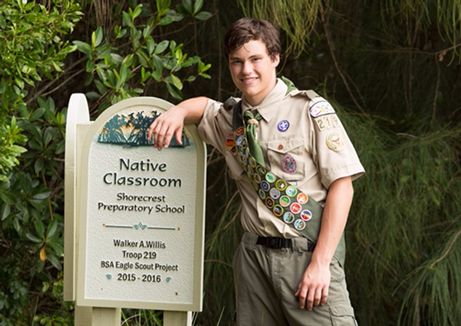

Visiting the Native Classroom
Source/Author: Nancy L. Spencer, Head of School
February 26, 2021
Soon after my arrival at Shorecrest last summer, I asked Director of Facilities Dave Sharlow if he would take me on what I called a “boilers and basement tour” of the campus. He gently informed me that Shorecrest buildings do not have basements and that we do not use boilers as an HVAC system! My point was that I wanted a backstage tour of the campus, and Dave was very willing to provide me with one.
On a warm July afternoon, I climbed into Dave’s golf cart and he drove me all around Shorecrest’s 28 acres for a peek behind the scenes. We cruised from First Street to the pond behind the baseball field (no alligators are living in there right now, although there was one such inhabitant in years past they say…) We then headed towards the back side of campus, behind the football field, to see the Native Classroom.
On a warm July afternoon, I climbed into Dave’s golf cart and he drove me all around Shorecrest’s 28 acres for a peek behind the scenes. We cruised from First Street to the pond behind the baseball field (no alligators are living in there right now, although there was one such inhabitant in years past they say…) We then headed towards the back side of campus, behind the football field, to see the Native Classroom.
"The Native Classroom" has a rich history connected to Shorecrest alumnus and legacy student Walker Willis ’19.
Walker undertook a restoration and conservation project to improve an important Tampa Bay estuary along the 54th Avenue Channel in St. Petersburg, Florida. The channel is adjacent to the Shorecrest Preparatory School campus. The three-phase project started with the eradication of approximately 1,000 invasive Australian Pines, trees and saplings. Phase two involved planting 500 mangroves, cabbage palms, slash pines, and other native species to enrich habitat, insure soil conservation, and improve water quality. In the final phase, Walker improved an existing educational area by building a channel-side observation ground platform and providing a freshwater source for science students. This area is also utilized by English students inspired to write about nature, and all students of native outdoor gardening and conservation.
The Native Classroom was the focus of Walker’s eighth grade passion project. In addition to earning his Eagle Scout Award for this project, Walker was also awarded the prestigious Boy Scouts of America William T. Hornaday Silver Medal for his efforts to create the Native Classroom.
Recently, I joined Ms. Parrott’s seventh-grade science class as they went on one of their regular visits to the Native Classroom. The goal for this class was to observe the environment, then record their observations and reflections in their nature journals.
To be candid, I am not particularly knowledgeable about plants or birds. I listened carefully to Ms. Parrott as she identified certain species of plants and talked about the habitat around us. When the students set off for their independent research, I tagged along with a few of them as they pointed out the turkey vultures soaring above us and gasped at a tiny spider spinning its web, nestled between the leaves. We could barely make out the insect, as it was the size of the head of a pin. We saw minnows swimming in the canal, and numerous varieties of plants, trees and leaves. We listened to the birds calling to one another, and I noticed the huge nests on the lights that surround the track and football field.
More than anything I was struck by the curiosity of the students, the knowledge of their science teacher and the peaceful nature of being outdoors in the middle of the day. I am amazed by the richness of this environment and how much we have to learn from the opportunities that abound on this campus. It is yet another reason that I love Shorecrest.
All the best,
























